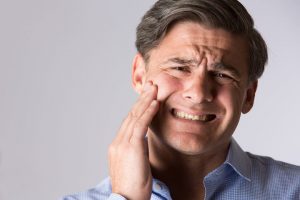
Are you having trouble opening your mouth in the morning? Are constant headaches interrupting your day-to-day activities? You may have a temporomandibular joint disorder, or TMD. If left untreated, this painful condition can seriously affect your quality of life. Fortunately, a neuromuscular dentist can help. Keep reading to learn about common TMD causes and how to relieve your jaw pain.
What Is TMD?
TMD stands for temporomandibular joint disorder and is an umbrella term for various issues that cause pain in the joints, muscles, and facial nerves that control jaw movement.
The temporomandibular joint (TMJ) is the point on either side of the head where the jaw meets the upper skull. These unique joints are made up of the rounded bone of the upper jaw and a disc-like structure made of cartilage. Ligaments in the head and neck hold the joint together and help guide jaw movement. You use your TMJ every day for eating, speaking, laughing, and even yawning.
Common TMD symptoms include:
- Difficulty chewing or biting
- Persistent headaches
- Pain in the neck, shoulders, and back
- A clicking sound when opening or closing your mouth, especially when chewing
- Locking of your jaw
- Ringing in the ear
- Dizziness and vision problems
- Tooth sensitivity
- Light sensitivity
What Are Common TMD Causes?
According to the American Association of Family Physicians, TMD affects up to 15% of adults. However, despite being fairly common, pinning down the exact cause of TMD can be difficult. Your jaw pain may be due to a combination of factors, including:
- Grinding teeth
- Bite misalignment
- Stress
- Arthritis
- Physical trauma
- Infections
- Poor posture
How Can a Neuromuscular Dentist Help?
Neuromuscular dentists undergo advanced training on how to discover and treat misalignment or malfunction in the muscles and nerves of the jaw. Here is what you can expect when you seek TMD pain relief from a neuromuscular dentist:
- Step 1: Your dentist may use a Transcutaneous Electrical Neural Stimulation (TENS) unit to assess your jaw problems. This state-of-the-art technology delivers low-frequency electrical impulses to the muscles that control jaw movement, causing them to relax. A K-7 machine will record the relaxed position of your jaw so your dentist can determine the best way to treat you.
- Step 2: Next, your dentist will craft a custom orthotic appliance. This is a small device worn in the mouth that gently forces the jaw into a more natural and comfortable position.
- Step 3: After three months with your orthotic appliance, you will return to your dentist for a checkup. They will assess whether or not the orthotic appliance has alleviated symptoms and determine if further therapy is required.
Dealing with a sore jaw, neck, or head every day just isn’t worth it. Talk to your dentist today about how you can overcome TMD pain.
About the Author
Dr. Carol F. Morgan has over 20 years of experience helping patients relieve jaw pain with TMJ therapy. She has completed post-graduate courses in neuromuscular dentistry and regularly treats patients with TMD. To learn more about temporomandibular disorders, visit the Hampton Roads Center for Cosmetic Dentistry website or call 757-412-1400.
